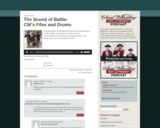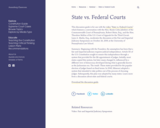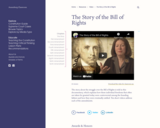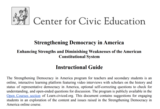
Historian James Oliver Horton briefly examines the protections for slavery embedded in the US Constitution.
- Subject:
- History
- Social Science
- Material Type:
- Lecture
- Provider:
- Gilder Lehrman Institute of American History
- Date Added:
- 05/10/2024

Historian James Oliver Horton briefly examines the protections for slavery embedded in the US Constitution.

In this interactive lesson supporting literacy skills in U.S. history, students learn about the debate over slavery at the Constitutional Convention in 1787. Students explore the changing perception of slavery in the new United States and the ways in which the debate over slavery affected the content of the Constitution. During this process, they read informational text, learn and practice vocabulary words, and explore content through videos and engagement activities.

The Constitutional Convention of 1787 brought together strong-willed representatives with opposing points of view on slavery and its future. To ensure passage of the Constitution itself, the representatives deemed it necessary to find a path forward that could be agreed to, with the understanding that the consequences of those actions would impact future generations. We are those future generations. We look back at this founding document and the challenging perspectives of our past and present with hope for the future. This panel discussion will be interspersed with dramatic interpretations from perspectives of the time period.

The term "social contract" refers to the idea that the state exists only to serve the will of the people, who are the source of all political power enjoyed by the state. The people can choose to give or withhold this power. The idea of the social contract is one of the foundations of the American political system.

Since 2005, the "Past and Present" podcast from Colonial Williamsburg has taken you behind the scenes to meet interpreters, chefs, tradesmen, musicians, historians, curators, and more. We offer two versions of our podcast: one that's audio-only and one that includes a slideshow. In this episode: The piercing fife, the thundering drum: both can be heard over the din of battle, making them a crucial means of communication for commands like parley, cease fire, and retreat. How does this combination work?

South Dakota v. Dole (1986) tested whether Congress could place conditions on the distribution of federal funding. The case focused on the National Minimum Drinking Age Act, which Congress had passed in 1984. The act determined that a percentage of federal funding for state highways could be withheld if states failed to raise their minimum drinking age to 21.

Until 1804, American presidents were elected under a system established in the US Constitution in which each member of the Electoral College voted for two presidential candidates. The candidate who received the most votes became president; the candidate with the second-most votes became vice president.

This discussion guide is for use with the video âState vs. Federal Courts,â which features a conversation with the Hon. Renée Cohn Jubelirer of the Commonwealth Court of Pennsylvania, Robert Heim, Esq., and the Hon. Theodore McKee of the U.S. Court of Appeals for the Third Circuit. Lynn A. Marks, Esq., moderates the discussion at the Fair and Impartial Judiciary Symposium on October 26, 2019, at the University of Pennsylvania Law School.

In this lesson, students examine key events from the life of former President Barack Obama in order to understand the "stepping stones" that led him to become the first Black president of the United States. Access to this resource requires a free educator login.

The story about the struggle over the Bill of Rights is told in this documentary, which explains how these individual freedoms that often are taken for granted today were controversial among the founding fathers and how they were eventually ratified. Ten short videos address each of the amendments.

Street Law Text/HTML great resources for teaching Supreme Court Cases

This draft guide provides suggestions for engaging high school students in exploration of the content and issues raised in the Strengthening Democracy in America courses.

In Strickland v. Washington (1986) the U.S. Supreme Court designed standards for determining when an attorney’s assistance has been so ineffective that it creates a violation of the Sixth Amendment.

Explore the evolution of students’ rights inside the schoolhouse gates and beyond using an interactive timeline and associated resources

This resource provides brief explanations of all the amendments that are part of the Bill of Rights.

Explore the history of U.S. voting rights, from its early influences to constitutional amendments and landmark Supreme Court cases using an interactive timeline and associated resources.

In this lesson, students will explore the First Amendment's freedom of the press as they examine sources related to government censorship of the press. They design and create their own poster promoting freedom of the press today. Access to this resource requires a free educator login.

The purpose of this lesson is to help students understand the original purpose and powers of the Supreme Court according to the Constitution. Students will learn the Supreme Court’s role in preserving the U.S. Constitution and the balance of power it creates. In this lesson, students will learn about the powers of the Supreme Court according to the Constitution through a guided hidden message activity and vocabulary lesson. An extension activity links this understanding of the Court to the development of judicial review in Marbury v. Madison.

Check out a sampling of the “don’t miss” highlights of the Supreme Court Building and the ground floor exhibits created by the Office of the Curator.

Civil Rights and Civil Liberties lesson that has students identify civil liberties and discuss the difference between civil rights and civil liberties. Then students examine the principle of civil liberties within the context of World War II. TM